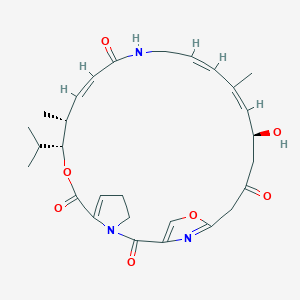Drug Information
Drug (ID: DG00374) and It's Reported Resistant Information
| Name |
Pristinamycin IIA
|
||||
|---|---|---|---|---|---|
| Synonyms |
Virginiamycin m1; Streptogramin A; Mikamycin A; Pristinamycin IIA; Ostreogrycin a; Virginiamycin Factor M1; 21411-53-0; UNII-8W4UOL59AZ; 8W4UOL59AZ; CHEBI:9997; VERNAMYCIN A; NSC87434; NSC 244426; Vernamycin A & B mixture; SCHEMBL673193; CHEMBL1236670; HY-N6686; EINECS 244-376-6; MFCD00869411; NSC 87432; NSC-87434; Vernamycin A & vernamycin B (1:1); DB01669; Vernamycin A, mixture with vernamycin B; VERNAMYCIN A & B MIXTURE (1:1); CS-0019826; Virginiamycin M1 100 microg/mL in Acetonitrile; UNII-4O8O7Q7IU4 component DAIKHDNSXMZDCU-FQTGFAPKSA-N; (3R,4R,5E,10E,12E,14S)-14-hydroxy-3-isopropyl-4,12-dimethyl-8,9,14,15,24,25-hexahydro-1H,3H,22H-21,18-(azeno)pyrrolo[2,1-c][1,8,4,19]dioxadiazacyclotetracosine-1,7,16,22(4H,17H)-tetrone; (3R,4R,5E,10E,12E,14S)-14-hydroxy-4,12-dimethyl-3-(1-methylethyl)-8,9,14,15,24,25-hexahydro-1H,3H,22H-21,18-(azeno)pyrrolo[2,1-c][1,8,4,19]dioxadiazacyclotetracosine-1,7,16,22(4H,17H)-tetrone; 8,9,14,15,24,25-Hexahydro-14-hydroxy-3-isopropyl-4,12-dimethyl-3H-21,18-nitrilo-1H,22H-pyrrolo(2,1-c)(1,8,4,19)dioxadiazacyclotetracosine-1,7,16,22(4H,17H)-tetrone; 8,9,14,15,24,25-Hexahydro-14-hydroxy-4,12-dimethyl-3-(1-methylethyl)-3H-21,18-nitrilo-1H,22H-pyrrolo(2,1-c)(1,8,4,19)dioxadiazacyclotetracosine-1,7,16,22(4H,17H)-tetrone
Click to Show/Hide
|
||||
| Structure |

|
||||
| Drug Resistance Disease(s) |
Disease(s) with Clinically Reported Resistance for This Drug
(1 diseases)
[1]
|
||||
| Click to Show/Hide the Molecular Information and External Link(s) of This Drug | |||||
| Formula |
C28H35N3O7
|
||||
| IsoSMILES |
C[C@@H]1/C=C/C(=O)NC/C=C/C(=C/[C@H](CC(=O)CC2=NC(=CO2)C(=O)N3CCC=C3C(=O)O[C@@H]1C(C)C)O)/C
|
||||
| InChI |
1S/C28H35N3O7/c1-17(2)26-19(4)9-10-24(34)29-11-5-7-18(3)13-20(32)14-21(33)15-25-30-22(16-37-25)27(35)31-12-6-8-23(31)28(36)38-26/h5,7-10,13,16-17,19-20,26,32H,6,11-12,14-15H2,1-4H3,(H,29,34)/b7-5+,10-9+,18-13+/t19-,20-,26-/m1/s1
|
||||
| InChIKey |
DAIKHDNSXMZDCU-FQTGFAPKSA-N
|
||||
| PubChem CID | |||||
| DrugBank ID | |||||
Type(s) of Resistant Mechanism of This Drug
Drug Resistance Data Categorized by Their Corresponding Diseases
ICD-01: Infectious/parasitic diseases
| Drug Resistance Data Categorized by Their Corresponding Mechanisms | ||||
|
|
||||
| Key Molecule: 23S rRNA (Adenine(2503)-C(8))-methyltransferase ClbA (CIBA) | [1] | |||
| Molecule Alteration | Expression | Up-regulation |
||
| Resistant Disease | Bacterial infection [ICD-11: 1A00-1C4Z] | |||
| Experimental Note | Identified from the Human Clinical Data | |||
| In Vitro Model | Escherichia coli AS19 | 562 | ||
| Escherichia coli JW2501-1 | 562 | |||
| Experiment for Molecule Alteration |
Whole genome sequence assay; Allelic frequency measurement assay | |||
| Experiment for Drug Resistance |
MIC assay | |||
| Mechanism Description | The cfr gene encodes the Cfr methyltransferase that methylates a single adenine in the peptidyl transferase region of bacterial ribosomes.Expression of the genes was induced in Escherichia coli, and MICs for selected antibiotics indicate that the cfr-like genes confer resistance to PhLOPSa (phenicol, lincosamide, oxazolidinone, pleuromutilin, and streptogramin A) antibiotics in the same way as the cfr gene.The Cfr-like proteins ClbA, ClbC, and ClbB confer a resistance pattern similar to that of the Cfr methyltransferase. | |||
|
|
||||
| Key Molecule: ABC superfamily ATP binding cassette transporter (ABCCT) | [2], [3] | |||
| Molecule Alteration | Expression | Inherence |
||
| Resistant Disease | Bacterial infection [ICD-11: 1A00-1C4Z] | |||
| Experimental Note | Identified from the Human Clinical Data | |||
| In Vitro Model | Escherichia coli TOP10 | 83333 | ||
| Staphylococcus aureus RN4220 | 1280 | |||
| Staphylococcus saprophyticus ATCC 15305 | 342451 | |||
| Staphylococcus sciuri ATCC 29059 | 1296 | |||
| Staphylococcus sciuri ATCC 29062 | 1296 | |||
| Staphylococcus sciuri ATCC 700058 | 1296 | |||
| Staphylococcus sciuri ATCC 700061 | 1296 | |||
| Staphylococcus sciuri BL2 | 1296 | |||
| Staphylococcus sciuri SS226 | 1296 | |||
| Staphylococcus sciuri SVv1 | 1296 | |||
| Experiment for Molecule Alteration |
Whole genome sequence assay | |||
| Experiment for Drug Resistance |
Disk diffusion test assay; E-strip test assay | |||
| Mechanism Description | Efflux-mediated resistance to MLS antibiotics in staphylococci relies on the ATPase activity of a very special kind of ATP-binding cassette (ABC) protein.By whole-genome sequencing of strain ATCC 29059, we identified a candidate gene that encodes an ATP-binding cassette protein similar to the Lsa and VmlR resistance determinants. Isolation and reverse transcription-quantitative PCR (qRT-PCR) expression studies confirmed that Sal(A) can confer a moderate resistance to lincosamides (8 times the MIC of lincomycin) and a high-level resistance to streptogramins A. The chromosomal location of sal(A) between two housekeeping genes of the staphylococcal core genome supports the gene's ancient origins and thus innate resistance to these antimicrobials within S. sciuri subspecies. | |||
|
|
||||
| Key Molecule: Colibactin polyketide synthase ClbC (CLBC) | [1] | |||
| Molecule Alteration | Expression | Up-regulation |
||
| Resistant Disease | Bacterial infection [ICD-11: 1A00-1C4Z] | |||
| Experimental Note | Identified from the Human Clinical Data | |||
| In Vitro Model | Escherichia coli AS19 | 562 | ||
| Escherichia coli JW2501-1 | 562 | |||
| Experiment for Molecule Alteration |
Whole genome sequence assay; Allelic frequency measurement assay | |||
| Experiment for Drug Resistance |
MIC assay | |||
| Mechanism Description | The cfr gene encodes the Cfr methyltransferase that methylates a single adenine in the peptidyl transferase region of bacterial ribosomes.Expression of the genes was induced in Escherichia coli, and MICs for selected antibiotics indicate that the cfr-like genes confer resistance to PhLOPSa (phenicol, lincosamide, oxazolidinone, pleuromutilin, and streptogramin A) antibiotics in the same way as the cfr gene.The Cfr-like proteins ClbA, ClbC, and ClbB confer a resistance pattern similar to that of the Cfr methyltransferase. | |||
References
If you find any error in data or bug in web service, please kindly report it to Dr. Sun and Dr. Zhang.
